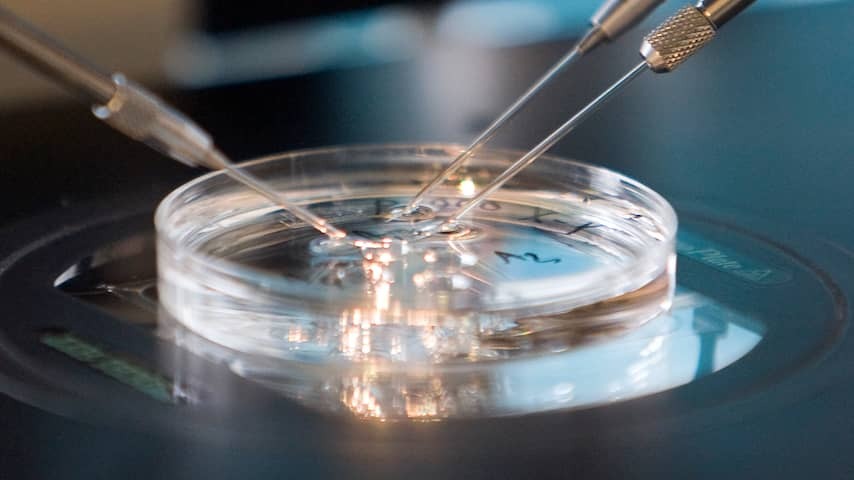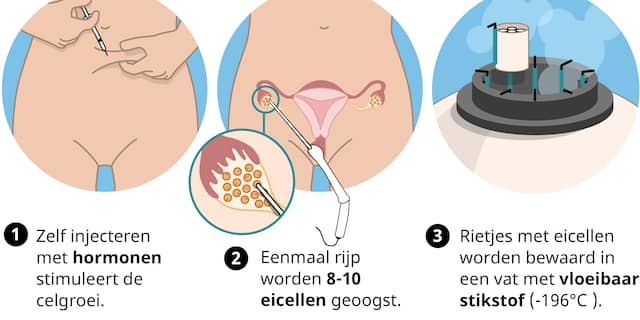
If you have a desire to have children but do not have the opportunity to start a family now, it can be a nice feeling to have your cells in the freezer. Ready to be fertilized when you want. Are you thinking about having your cells frozen? Here’s what you need to know about the chance of an actual baby.
Women who want to have their eggs frozen feel the hot breath of their biological clock breathing down their necks, says Prof. Dr. Joop Laven. He is Professor of Gynecology at Erasmus MC. “I tell them that freezing does not mean that you still have every chance in the world afterwards. They are often in their late thirties, and these women should actually get started immediately. Not with freezing and IVF, but with trying to have a child right now.”
And that is what they don’t want or can’t do. So they report to the correct counter in the hospital to start the freezing process. First, the AMH value in the blood is checked, the Anti-Müllerian Hormone. That is the only good and most reliable marker to predict the egg cell supply in women, says Laven.
Your ovarian age and biological age
Your ovarian age can be ahead of your real age, says Laven. “If your AMH value is below the average for your age, then you have to get started now. I then advise against freezing, because that would give false hope. The quality of what we then freeze is not high enough to lead to a live-born child. That has to do with the fact that at the end of the period in which you are still fertile, egg cell quality seems to go hand in hand with the number of egg cells.”
With such a low AMH value, other options are also discussed. “A single frozen egg cell has a 2 percent chance of becoming a live-born child. With a frozen embryo that is 20 percent.”
In order to be able to freeze an embryo, sperm is needed, and so someone who is told that their AMH value is low suddenly has to think about whether single parenthood thanks to donor sperm is an option. “Sometimes that answer is very clearly no. Then I tell them that the chance of having a child spontaneously after your fortieth is very, very small.” They exist, women who suddenly turn out to be pregnant at 43, but you probably know a maximum of one in your immediate environment.
The price tag
Freezing egg cells is expensive. If there is no direct medical reason to have them frozen, this is called social freezing. Per round you pay around 4,000 euros. The younger you are, the more egg cells you catch per cycle. You need about twenty if you are forty. Someone of forty years old will not be able to harvest that number with one cycle, and therefore pay that 4,000 euros several times. If you have egg cells frozen at the age of thirty, you may only need one cycle for twelve cells and thus have an 80 percent chance of one live-born child. If this woman comes for fertility treatment ten years later, many more cycles are needed and the egg cells are of much lower quality.
For women who have to undergo chemotherapy or an ovarian operation, or for trans men, the treatment is reimbursed. The term social freezing is nonsensical, says Laven. “When does social end and when does medical begin? I wouldn’t know and we have written it that way in the guideline about this. Yet the health insurers interpret that guideline differently and much more strictly.”
The legislation regarding reimbursement from the insurer, says Laven, cannot be explained. “Every woman who wants to have her eggs frozen has a legitimate reason.”
Eggs can be lost
An egg cell is a huge cell that you can see with the naked eye and it is important to handle it with extreme care, because the egg cell supply in women decreases rapidly and is not replenished – unlike male sperm cells. Harvesting, freezing and thawing again is not without risk. The cells can be lost in the process. The freezing method – vitrification – is fast and smart, but even then a cell can be punctured. You only know that when they are thawed. “We don’t know the quality of the cells that are frozen. If an egg cell already has DNA damage, due to your age or due to smoking, for example, then that cell is not fit for life. It will not be able to be fertilized and will therefore never produce a living child.”

What can you do yourself?
Don’t smoke, because that’s a killer for your egg cells. You damage the DNA in your egg cells with it. Laven: “We know from research that exposure to too many free oxygen radicals can cause DNA damage to the egg cells. This damage is caused, for example, by smoking, exposure to environmental pollution, or eating too much red meat. The damage can be repaired, one woman does that better than the other. But if you are already in your late thirties, the damage is greater than when you are in your early thirties. That is why fertility in women decreases rapidly in that period.”
In order to prevent unwanted childlessness and boost the fertility rate of the Netherlands, we must realize that having children after 35 is very difficult, says Laven. “Men really have to participate in this. They start thinking around their forties whether they might want a child, because then they are already well on their way in their careers. There is an incredible inequality around having children.”
Pay attention to family planning during sexual education in primary schools, says Laven, and make sure that boys also understand it. Before you turn 35, you should already have two children to prevent fertility treatments and unwanted childlessness. “A smart girl has her child on time. The smart girls to whom I present medical diplomas know that, but unfortunately they don’t do it either.”